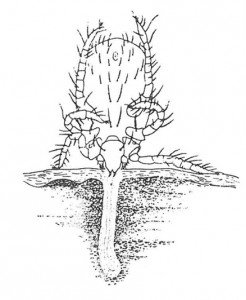
There are differences in frequency and severity of different peoples’ Trombiculosis. One in five people, who are bitten, do not react to the bite. Newcomers in areas in which there are many harvest mites will not usually develop Trombiculosis during the first season, but they will the following year.
The bite
The harvest mite usually bites the ankles, knees, skin folds in and around the crotch, waist, armpits and the neck. In contrast to scabies, the bite wounds are rarely found on the forearms and hands. The larva bite is completely painless. It drills the little mouth parts into the skin and secrete enzyme-containing saliva into the wound. 3-5 hours later a severe itching occurs which can last up to 3 weeks. The itching worsens in warmth of the bed, after showering and rubbing and after scratching. Near the bites wounds, a red small red papule appears on the skin. In its centre, the mite is seen as a small red dot. Later, the bite wound swells up and is red and swollen (Trombiculosis). After some time, liquid-filled blisters are formed in the centre and the surrounding skin is red and warm. The bites heal by themselves, unless scratching causes holes and inflammation in the wound.
The stylostome
The larva’s saliva causes the victim’s skin to form a kind of straw, a stylostome that is half as long as the mite. This stylostome often leaves the host as a trunk-shaped extension of the mite when it – more or less voluntarily – loosens its grip. The stylostome is thick-walled. It has a diameter of 35-40 micrometers and the internal channel is only 5-10 micrometers wide. The larva feeds on lymphatic and dissolved tissue through the stylostome. At the same time, the stylostome functions as an anchor to harvest mite larvae.
The identification is ensured by placing the mites found on a microscope slide with a drop of Hoyer’s Medium for further examination in microscopes of high magnification. The animals can be easily be caught on a piece of adhesive tape. The harvest mite larva is red. There are other red or reddish mites that are found around houses, trees, rocks, and walls. For example, the red wall mite, Balaustium murorum and the clover mite, Bryobia praetiosa. However, they are both commonly found in the spring and it is the nymphal stages, you see. Unlike the harvest mite larva, which has six legs, they have eight legs.




